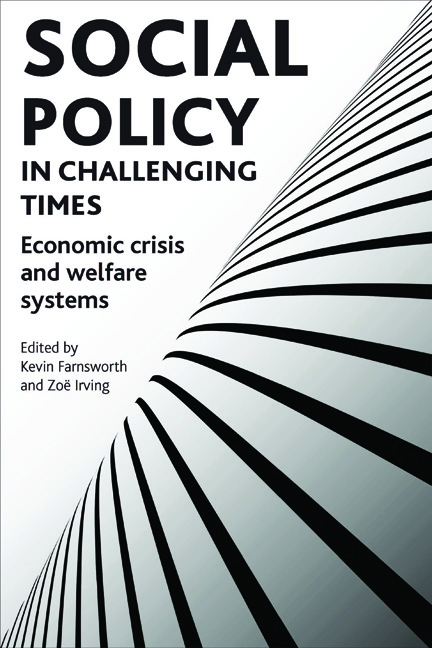Book contents
- Frontmatter
- Contents
- List of figures and tables
- Notes on contributors
- Acknowledgements
- one Varieties of crisis
- two The economic crisis and paradigm change
- three From financial crisis to fiscal crisis
- four Credit crunch, inequality and social policy
- five Global social policy responses to the economic crisis
- six Poverty, the crisis and social policy responses developing countries in developing countries
- seven South Korea after the 1997 economic crisis: a ‘paradigm shift’?
- eight China's response to crisis: what role for social policy?
- nine Tiptoeing through crisis? Re-evaluating the German social model in light of the global recession
- ten Ireland and the impact of the economic crisis: upholding the dominant policy paradigm
- eleven Waving not drowning: Iceland, kreppan and alternative social policy futures
- twelve Experiences from two financial crises in the Nordic welfare states: 1990-93 and 2008-10 compared
- thirteen Social policy and the recent economic crisis in Canada and the United States
- fourteen From economic crisis to a new age of austerity: the UK
- fifteen Responding to the challenges: some concluding remarks on welfare futures in changed circumstances
- Bibliography
- Index
twelve - Experiences from two financial crises in the Nordic welfare states: 1990-93 and 2008-10 compared
Published online by Cambridge University Press: 07 September 2022
- Frontmatter
- Contents
- List of figures and tables
- Notes on contributors
- Acknowledgements
- one Varieties of crisis
- two The economic crisis and paradigm change
- three From financial crisis to fiscal crisis
- four Credit crunch, inequality and social policy
- five Global social policy responses to the economic crisis
- six Poverty, the crisis and social policy responses developing countries in developing countries
- seven South Korea after the 1997 economic crisis: a ‘paradigm shift’?
- eight China's response to crisis: what role for social policy?
- nine Tiptoeing through crisis? Re-evaluating the German social model in light of the global recession
- ten Ireland and the impact of the economic crisis: upholding the dominant policy paradigm
- eleven Waving not drowning: Iceland, kreppan and alternative social policy futures
- twelve Experiences from two financial crises in the Nordic welfare states: 1990-93 and 2008-10 compared
- thirteen Social policy and the recent economic crisis in Canada and the United States
- fourteen From economic crisis to a new age of austerity: the UK
- fifteen Responding to the challenges: some concluding remarks on welfare futures in changed circumstances
- Bibliography
- Index
Summary
Introduction
This chapter examines the 2008 economic crisis in three small Nordic countries: Denmark, Finland and Sweden. It compares the responses in these countries to the 2008 crisis with the financial crisis of the early 1990s. The structure of the chapter is as follows. First, the regulatory regimes of Nordic welfare states are explored. Second, the roots of the early 1990s financial crisis are analysed. Last, the economic and financial crisis from 2008 to 2010 is examined with a particular focus on the implications this has had for social policy.
On the basis that financial markets are inherent unstable, and given that the instabilities may be self-reinforcing and even self-devastating, financial crises are to be expected. These are even more likely if there is no, or very weak, public regulation of the markets. From 2007, these instabilities were strengthened in the financial (and housing) markets in the United States (US), leading to severe losses and even to a fall of big investment banks. However, as is argued elsewhere in the book, it soon became evident that the crisis was not restricted to the US, but was global in nature. The global financial and economic crisis from 2008 onwards extended also to the Nordic countries (in short: the Nordics). In these countries too, banks have faced difficulties; exports and Gross Domestic Product (GDP) levels have fallen dramatically and various rescue measures have been introduced. However, especially in Finland and Sweden, a deep recession and banking crisis had already been experienced in 1990-93. This was followed by mass unemployment and cuts in social entitlements. This chapter extends the analysis of ‘varieties of crisis’ between states by introducing a temporal dimension: looking at the impact of different crises over time.
National systems of regulation and the rise of the Nordic welfare states
The Nordics in the post-war period can be described, maybe paradoxically, as open but regulated economies. It is often the case that small states have relatively open economies; they generally have small home markets and large shares of imports and exports in relation to national product. Because of their relatively small production capacity and tendency to produce highly specialised goods, small states rely heavily on imports to support general consumption and high levels of exports to ensure a healthy trade balance. In addition, many small states have relatively high levels of inward and outward foreign direct investments.
- Type
- Chapter
- Information
- Social Policy in Challenging TimesEconomic Crisis and Welfare Systems, pp. 219 - 230Publisher: Bristol University PressPrint publication year: 2011



